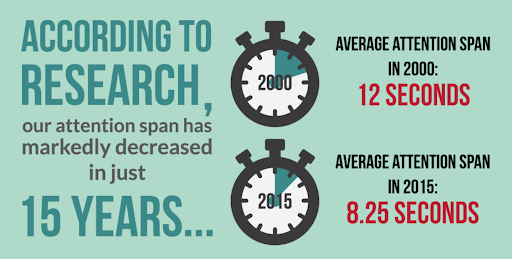SEO Content Writing Tips, And Dos & Don’ts for Top Rankings in 2024

SEO content, a work of art,
For websites to play their part.
In search engine results to shine,
Your content must be found by users online.
(Thanks, ChatGPT!)
SEO isn’t what it once was.
Try searching for something and see if you find what you were looking for in the top three organic results.
Years ago, you would search for black jeans, and most likely find the perfect item or store on the first SERP. There was an 80% chance you could see it in the top few results.
Today, with an explosion of content (set to expand tenfold with the use of AI for SEO content writing), it’s even more important to create high-quality, well-researched content that can provide instant value.
With an attention span of just 8.25 seconds, no one has time or headspace for bland content.

Source: Wyzowl
With so much competition to get those top rankings, your content simply has to be entertaining, educating, and/or inspiring. It has to give value, be engaging, and readable, and follow important SEO guidelines – all at the same time.
It’s a tall order, so we’re here to help with SEO content writing tips to make the SEO part a bit easier for you. And scroll down to the end to see our quick list of dos and don’ts!
Step-by-Step Guide for Successful SEO Writing in 2024
Step 1: Keyword research for SEO content
Always start with keyword research to identify the most relevant and popular keywords related to your topic. Think ‘outside-in’ – what your audience is interested in and searching for, rather than what seems interesting to you or your business.
Pick 3 to 5 primary keywords you want your article to rank for, and check that there is good search volume.
Tip: “Good search volume” is a minimum of 100-1000 searches per month.
Use free tools like https://www.wordstream.com/keywords, https://questiondb.io/ or https://answerthepublic.com to help you.
Step 2: Write for your audience
Write high-quality, informative, and engaging content that your audience will find valuable and shareable.
Google your chosen keywords and research the type of content already written on this subject matter; this is your competition, and your content needs to be better.
Tip: Choose five articles that are ranking well in the niche, and read them thoroughly. Go through the reader comments (if there are any), and see what the discussion is all about. Think about new or original topics that arise from the current conversations. Consider how you might bring something fresh, different, or unique to the topic. That’s what you should be writing about.
Step 3: Optimize your headlines
Your blog post headline [H1] is one of the most important elements for SEO. Use your main keyword in the headline and try to make it catchy and attention-grabbing. Use tools like CoSchedule Headline Analyzer to check the headline’s readability and emotional impact.
Use subheadings [H2] to break up content and make it easier to read. Ensure the primary keywords are in the subheadings.
Tip: You can use [H3] sub-subheadings for lists. For example, in the article you are reading now, each step (Step 1, Step 2, etc) is [H3].
Step 4: Use internal and external links
Links – both internal on your own blog or website, or external to other blogs or sites – are really important for SEO. Internal links to other relevant pages on your website will help Google crawlers find your blog post. Linking to high-quality external sources adds credibility by association to your content, which is really important to improve your SEO.
Tip: Don’t link just for the sake of it. Make sure that the links are relevant and authoritative, and enrich the reading experience.
Step 5: Optimize your meta tags
The title tag and meta description of your content page are crucial elements for SEO.
- The title tag contains your main keyword and must be within the recommended character limit (60-70 characters).
- The meta description should include main and secondary keywords if possible, and also be informative and enticing (up to 160 characters).

Tip: Although meta tags are ‘technical’ elements of your content, don’t forget that people will be seeing them (not just crawlers). So they should describe the content in a way that is attractive to your readers and to Google!
(Bonus) Step 6: Analyze, learn, repeat.
Use Google Analytics to monitor your site or blog’s traffic, bounce rate, and other key metrics. This will help you identify areas for improvement and make data-driven decisions.
Quick Guide: Dos and Don’ts of SEO Content Writing
Originality
- Do NOT rely on ChatGPT. Sure, every content writer is exploring how to use AI, but the trick is using it wisely. ChatGPT is a great tool for research and brainstorming, but you need your own voice to shine. It won’t if you give the job to ChatGPT.
- Do NOT copy other websites’ content. So this is a pretty obvious one, and apart from the ethical issues, you simply won’t rank on SERPs if you use duplicate content. By the way, this applies to content from your own website too.
- Do check all content for plagiarism.
- Do use plagiarism checker tools like www.duplichecker.com and www.plagiarismdetector.net,
Creativity
- DO NOT write content that you find boring. If it’s boring to the writer, it will be boring to the reader.
- DO NOT write ‘thin’ content that provides little or no value to the user. Try to go deeper into the topic.
- DO write insightful content, backed up by authoritative resources and links.
- DO include your own opinion. This is what will make your content stand out from the crowd.
Images
- DO NOT use copyrighted images. Of course.
- DO include images when they support and enrich the reading experience, or support your claims.
- DO use screenshots, videos, tables, charts, graphs, and other visual elements where appropriate to make the content more engaging.
Keywords
- DO NOT stuff the article with keywords, or overuse keywords in an unnatural way. Make sure the keywords fit seamlessly into the content flow.
- DO use your primary keywords as much as possible.
Readability
- DO NOT write long paragraphs of text. Instead, break up the content into shorter bite-sized parts that won’t intimidate readers.
- DO use spacing and paragraph breaks liberally. This makes it easier to skim and consume the content.
- DO use bulleted lists, standout quotes, data, or tips, when they are relevant and appropriate. These make the page more eye-catching and readable, which search engines love.












